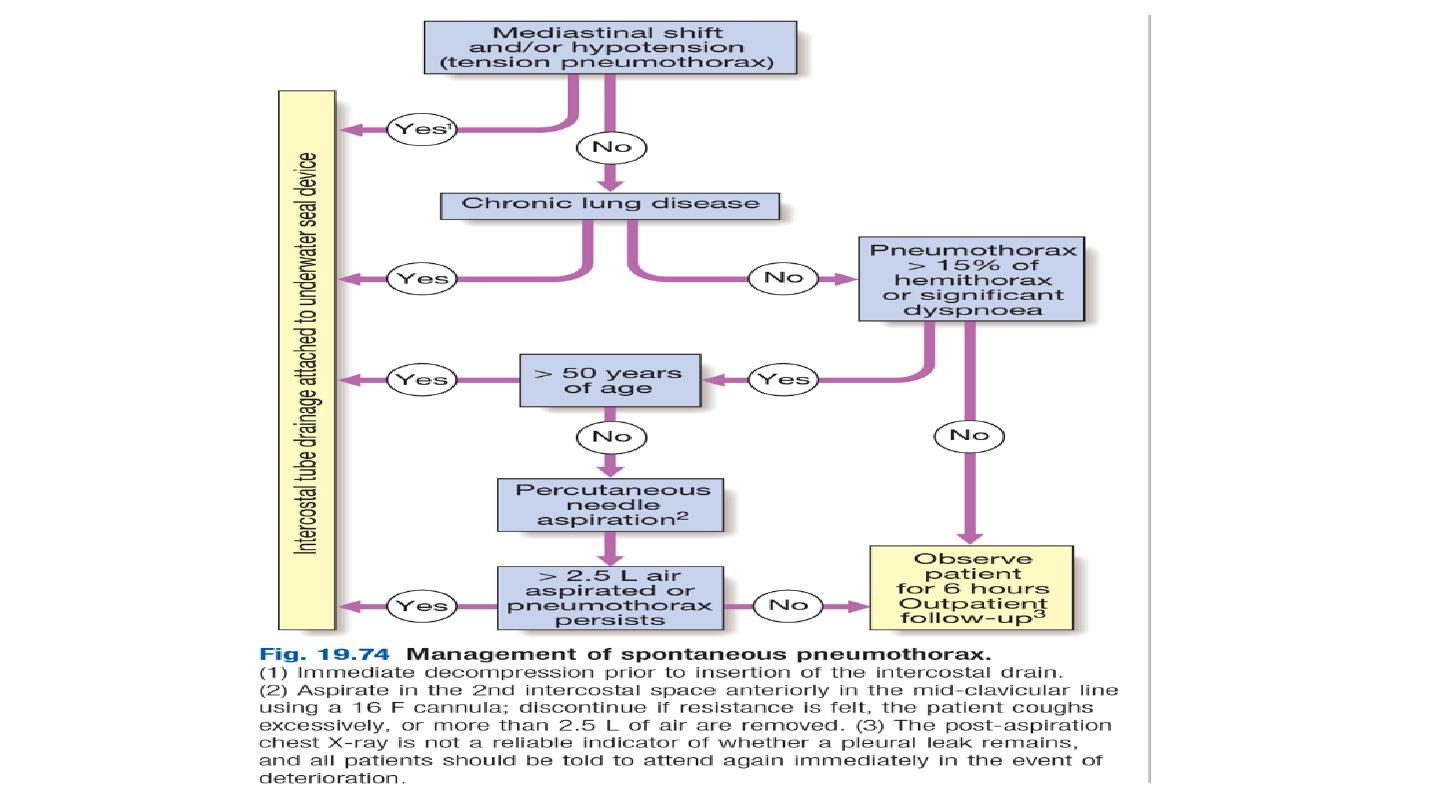
Parapneumonic effusion and empyema
Assistant prof.Dr.Ahmed Hussein Jasim (F.I.B.M.S)(resp)

Investigations
• Diagnostic pleural tap using US : is essential if pleural infection is possible and
fluid depth is >10mm (smaller effusions can usually be monitored).
Frankly
purulent or turbid/cloudy pleural fluid, organisms on pleural fluid Gram stain or
culture, or pleural fluid ph <7.2 are all indications for chest tube drainage
.
40%
of pleural infections are culture-negative.
• Contrast-enhanced pleural-phase CT may be useful both in supporting the
diagnosis and visualizing the distribution of fluid.
• Blood cultures positive in only 40% of cases.
• Bronchoscopy is only indicated if a bronchial obstructing lesion is suspected.

Management
• Antibiotics all patients with pleural infection should be treated with antibiotics;
refer to local hospital prescribing guidelines.
•
Community-acquired empyema—β-lactam/β-lactamase inhibitor (e.g. co-
amoxiclav) or second-generation cephalosporin (e.g. cefuroxime), combined with
metronidazole for anaerobic cover. Ciprofloxacin and clindamycin together may be
appropriate.
•
Hospital-acquired empyema—cover Gram-positive and Gram-negative organisms
and anaerobes. MRSA infection is common. Consult with microbiology team. One
option is meropenem and vancomycin.
• Chest tube drainage Indications for chest tube drainage • purulent pleural fluid •
Organisms on pleural fluid Gram stain or culture
• pleural fluid ph <7.2.

• Intrapleural fibrinolytics showed that the combination of intrapleural alteplase
(tpa) and dornase alfa (DNase) significantly improved CXr appearances for
patients with pleural infection ( 1° outcome) and reduced surgical referral and
hospital stay with a similar adverse event profile (2° outcomes).
• Nutritional support Dietician review; consider supplementary NG feeding.
• Thromboprophylaxis
• Surgery
Consult with thoracic surgeon if there are ongoing features of sepsis
and residual pleural collection after 5–7 days despite tube drainage and
treatment with antibiotics.
Outcome about 5% of patients require surgery. Empyema 1y mortality is about 5%.
Increased
age, renal impairment, low serum albumin, hypotension, and hospital-acquired infection are
associated with a poor outcome
. CXr may remain abnormal despite successful treatment of
empyema, with evidence of calcification or pleural scarring or thickening.

Pneumothorax
Definition a pneumothorax is air in the pleural space. May occur with apparently
normal lungs ( 1° pneumothorax) or in the presence of underlying lung disease (2°
pneumothorax). May occur spontaneously or following trauma.
Causes and pathophysiology
1°
pathogenesis is poorly understood; pneumothoraces are presumed to occur
following an air leak from apical subpleural blebs and bullae.
2°
Underlying diseases include: COpD (60% of cases), asthma, ILD, necrotizing
pneumonia, tB, PCP.

Clinical features
Classically presents with acute onset of pleuritic chest pain and/or breathlessness.
signs of pneumothorax include tachycardia, hyperinflation, reduced expansion,
hyperresonant percussion note, and quiet breath sounds on the pneumothorax side.
Investigations
o CXR is the diagnostic test in most cases, revealing a visible lung edge and absent
lung markings peripherally. Width of the rim of air surrounding the lung on CXr
may be used to classify pneumothoraces into small (rim of air measured at level
of hilum ≤2cm) and large (>2cm).
a 2cm rim of air approximately equates to a
50% pneumothorax in volume.

o ABGs frequently show hypoxia and sometimes hypercapnia in 2° pneumothorax.
o CT chest may be required to differentiate pneumothorax from bullous disease
and is useful in diagnosing unsuspected pneumothorax following trauma and in
looking for evidence of underlying lung disease.
Prognosis
Risk of recurrence increases with each subsequent pneumothorax; risk of
recurrence is around 30% after a first pneumothorax, about 40% after a second, and
>50% after a third
• Mortality of 2° pneumothorax is 10%

